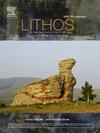The fate of solid-phase transfer in subduction zones: Evidence from Ti-oxides in Luobusa ophiolitic chromitite
IF 2.9
2区 地球科学
Q2 GEOCHEMISTRY & GEOPHYSICS
引用次数: 0
Abstract
The transport of hydrous components from a subducting oceanic plate to the supra-subduction lithospheric mantle and their influence on arc magmas is well-documented. Yet the transfer of solid-phase materials remains enigmatic, despite an increasing body of literature regarding inherited rutile in well-characterized arc magmas and ophiolitic chromitites. The mechanism governing the introduction of solid phases into the overlying mantle wedge as well as the duration of their residence are poorly understood. This study investigates mineralogical and geochemical characteristics of rutile inclusions in the Luobusa chromitite of southern Tibet.
In the investigated chromitite, rutile, associated with ilmenite, corundum, ulvöspinel, zircon, and melt silicate inclusions, exhibits geochemical characteristics indicative of derivation from crustal mafic rocks. Estimated formation or recrystallization temperatures of rutile range from 570 to 675 °C at approximately 1.2 GPa. These temperature estimates illustrate the challenges of obtaining accurate dating, as the rutile U![]() Pb system resets near 600 °C. The Fe/Zr ratios in Luobusa rutile serve as indicators of H2O/Zr ratios, suggesting a significant role for hydrous components in the behavior of high field strength elements (HFSE) during subduction processes.
Pb system resets near 600 °C. The Fe/Zr ratios in Luobusa rutile serve as indicators of H2O/Zr ratios, suggesting a significant role for hydrous components in the behavior of high field strength elements (HFSE) during subduction processes.
A fluid-assisted transport mechanism likely facilitated the movement of HFSE, such as Ti, V, Zr, Nb, and Ta, within accessory mineral phases into the supra-subduction mantle wedge. The presence of rutile and polymorphs of TiO₂, including Ti0.82Si0.18O2 and TiO2-II, within chromite crystals underscores the extensive recycling and recrystallization processes occurring under diverse mantle conditions during the genesis and evolution of the Luobusa ophiolites.

求助全文
约1分钟内获得全文
求助全文
来源期刊

Lithos
地学-地球化学与地球物理
CiteScore
6.80
自引率
11.40%
发文量
286
审稿时长
3.5 months
期刊介绍:
Lithos publishes original research papers on the petrology, geochemistry and petrogenesis of igneous and metamorphic rocks. Papers on mineralogy/mineral physics related to petrology and petrogenetic problems are also welcomed.
 求助内容:
求助内容: 应助结果提醒方式:
应助结果提醒方式:


